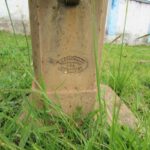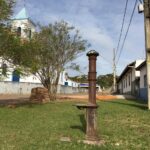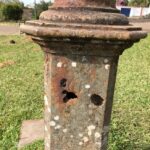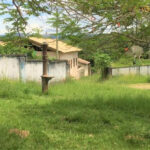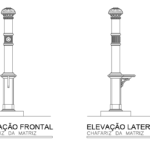
Mother Church Square Iron Fountain
The iron fountain, located in the main square of São Gonçalo do Bação, has a height of two meters and 10 cm, with a stamp in relief at its base, on the front, with the following indication: M. J. Moreira e Cia. Fabricantes 306 S. Pedro Rio de Janeiro.
The original faucet was replaced by a recent one in an improvised way, but it is one of the few that still has water, being a reference for tourists and residents who want to wash their hands. Some of the faithful, upon leaving mass at the parish church, wash their faces in the fountain.
According to Raimundo da Cruz dos Santos (a local resident known as Nem), in an interview with Thiago Damasceno in 2004 (Cf. Damasceno, 2004), the fountains were installed by the mayor of Ouro Preto, Dr. Joaquim Cândido da Costa Sena in a time when São Gonçalo belonged to Ouro Preto.
“Back then Mr. Joaquim paid a visit to this village and upon his arrival, asked Father Cândido, our parish priest, to get him some votes. He would, in turn, be very pleased and would contribute with one-inch iron pipes to bring the water from a place of his choice that could provide to our village of São Gonçalo. And Father Antônio, with all good will, asked the religious people of that time to vote for Joaquim Cândido da Costa Sena. He won politics. He became mayor of Ouro Preto and fulfilled his promise, sending the pipe boards to Engenheiro Correia. From Engenheiro Correia they were transported here in an oxcart, across the bridge that divides the region of Ouro Preto from Itabirito, the Cidreira bridge. On one side is Ouro Preto, on the other side, Itabirito. At that time, 1910, there was no ltabirito County In 1914, there was water at the square, which fell to the floor and gushed over the ground, for there was no reservoir. Four year later, at the end of his term, he (Costa Sena) sent more pipes and had a reservoir built. He also had water in the streets piped..”
It is located on a lawn in the free area between Firmino’s alley and Matrice Square (or Padre Benedito Firmino square), in a very visible place. It is a column fountain, which, in addition to supplying water collectively, gracefully and discreetly decorates the urban landscape. Made of cast iron, probably made in Europe, it is composed of an iron column resting on a concrete base, the latter with a square projection and chamfered edges. The lower part of the base is finished in a profile cut in a staggered way. The upper part of this short pillar is also finished off with a larger projection, in the form of a capital, with a framed profile and a rounded upper edge. The structure to support the utensils for capturing water projects forward, in a separate piece, forming a circular base, also in cast iron, with concentric rings, hollow, supported by a French hand made of iron, also hollow, composed of a half curve and a circle like bracing. The column is divided into three sections: the bottom, without ornamentation, the second, with wide, vertical grooves, from which the supply tap comes out, and the third, top, which receives crowning in the form of a simple capital with geometric and floral ornaments. At 2,10m high.
Narrativa
“It’s nice to wash your hands in this old fountain… It’s very beautiful here.” (Tourist)
According to Ms. Divina do Espírito Santo, 94 years old, resident of the Moura Lima Manor, the fountains were installed by Mayor Costa Sena in the main streets of São Gonçalo do Bação. Some fountains no longer exist, others have been changed places. The iron fountain on Nova street (New Street), for example, originally stood at the top, where the water tank is now located. Thus, there were iron and clay fountains (in this case, those made by the artist José Vitor). She only remembers two iron fountains.
The first to have piped water inside their houses were Father Antônio Cândido and his grandfather. After the support of the fountains to the other residents, the plumbing system of the other houses was built; the fountains have become relics of Bação’s history and art.
Registration in other heritage and environmental bodies
It is not listed as inventoried properties of the Itabirito City Hall or others.
Notes
-This set of inventories was prepared exclusively for the purpose of registering the cultural assets indicated by the community of São Gonçalo do Bação to meet the signaling, digital registration and enhancement program for Alleys, Fountains and Historic Attractions Circuits; - The contents of these inventories, if used in reports, other types of inventories and/or publications, must be duly cited, following ABNT rules; - The authorship of the photos and the origin of the iconographic collection (either personal or family collection) must be mentioned.
Bibliography
| DAMASCENO, Thiago Luiz M. “Chafarizes de São Gonçalo do Bação”. Monografia apresentada no Centro de Educação Tecnológica /CET - Itabirito, 2004. |
|---|
Information sponsors
Alenice Baeta, Cristina Cairo, Hudson Faria e Pedro Loredo.

